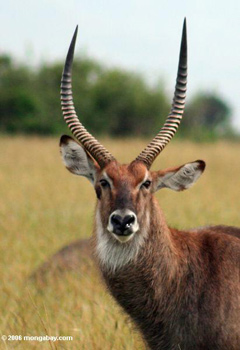Large mammals disappearing from Africa’s parks
Large mammals disappearing from Africa’s parks
mongabay.com
August 31, 2007
|
|
Large mammals are disappearing from Africa’s national parks, warn researchers writing in the September 2007 issue of the African Journal of Ecology.
Using new methods to analyze wildlife inventories across Africa, Tim Caro (University of California, Davis, USA) and Paul Scholte (Leiden University, the Netherlands) documented a decline in antelope populations both inside and outside wildlife preserves.
“Antelope populations have been poorly surveyed, and with the notable exceptions of the African Journal of Ecology articles, have failed to present quantitative information. What the new data show, is even relatively well-organised protected areas cannot be relied on as long-lasting conservation tools,” said Caro and Scholte.
 Male waterbuck (Kobus ellipsiprymnus) in Queen Elizabeth National Park, Uganda. Photo taken by Rhett A. Butler |
“The causes of the large mammal declines are principally anthropogenic. Many parks are subject to the ravaging impact of illegal hunters. In West-Central Africa, this bushmeat hunting used to cover local consumption only, now it includes tables in far off cities that extend to London and Paris. Then there are reserves in which human encroachment is the driving force, whereas in reserves too small to harbour wildlife populations year-round, natural and anthropogenic causes operate in concert”
Caro and Scholte caution that solutions to the decline must take in account the needs of local human populations that rely on game for subsistence.
“The idea of setting aside large tracts of land is outmoded by land-use change and demographics,” they write. “Increased patrols, equipment and incentives for park guards, in tandem with community outreach programs, will go some way to stop poaching; whereas opposition to land greedy development schemes may halt encroachment. But ultimately we may have to get used to faunal relaxation in Africa’s famous reserves leaving a continent containing isolated pockets of large mammal diversity living at low population sizes. Just like Europe”.
Related articles
Anti-poaching patrols paying off for safari wildlife in Tanzania
(11/23/2007) Enforcement patrols are effectively cutting poaching of elephants, African buffaloes and black rhinos in the Serengeti National Park in Tanzania according to new research published in the journal Science. Employing a sampling technique used to estimate the abundance of fish, an international team of scientists showed that poaching is down significantly in the Serengeti since the mid-1980s due to law enforcement efforts.
Bushmeat from African apes sold in American markets
(7/6/2006) Bushmeat from wild primates in Africa is ending up on plates in North America and western Europe according to an article published in the current issue of New Scientist. Justin Brashares, a wildlife biologist at the University of California at Berkeley who carried out a survey of clandestine markets in seven major cities, says that the meat, which includes chimpanzee and gorilla parts, makes up nearly a third of the illegal international trade in bushmeat killed in Africa.
Conserving wildlife in Tanzania, Africa’s most biodiverse country
(11/8/2007) With ecosystems ranging from Lake Tanganyika to Mt. Kilimanjaro, Tanzania is the most biodiverse country in Africa. Though Tanzania is world famous for its safari animals, the country is also home to two major biodiversity hotspots: the Eastern Arc Mountains and the Albertine Rift surrounding Lake Tanganyika. Tanzania has set aside nearly a quarter of its land mass in a network of protected areas and more than one-sixth of the country’s income is derived from tourism, much of which comes from nature-oriented travel.
Saving big cats depends on science, practical interventions
(5/21/2007) Big cats are some of Earth’s largest and most threatened predators. Long persecuted as perceived threats to livestock and humans, hunted for their skins and purported medicinal values, and losing critical habitat to deforestation and conversion for agriculture, big cat populations have dwindled around the world for the past century. Given these trends, it should come as no surprise that big cats have become the focus of conservation efforts. Not only are large predators often the most vulnerable to human pressures and the first to disappear from ecosystems, but efforts to conserve them effectively help protect thousands of other species that share their habitat. At the forefront of these efforts in Dr. Luke Hunter, a biologist with the Wildlife Conservation Society (WCS) where he heads their Great Cats Program. In a May 2007 interview with mongabay.com, Hunter discussed strategies for conserving carnivores and offered insight for students interested in pursuing careers in conservation science.
Commercial hunting may be biggest threat to tropical rainforests
(5/1/2007) Commercial hunting is decimating wildlife populations across the tropics and may be one of the gravest threats presently facing rainforests, reports a series of studies published in the May issue of the journal Biotropica. The research reveals that large-scale loss of wildlife is already affecting forest health and regeneration.